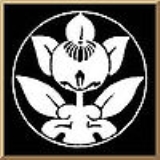
Ichimura Uzaemon XI
Encyclopedia
was a zamoto (theatre owner-manager) of the Ichimura-za
kabuki
theatre in Edo
, Japan
. Like many zamoto, he was raised in a kabuki family and trained to be an actor, but rarely actually appeared on stage.
His brother Bandō Kamezō I and son Ichimura Takenojō V were active actors on the stage, as were many of his grandsons, great-grandsons, and further descendants to whom he also passed on the position of zamoto. The current actors Nakamura Kantarō II
, Nakamura Shichinosuke II, and Bandō Kamesaburō V are his great-great-great-great-grandsons.
Uzaemon was only head of the Ichimura-za for fifteen years. During this short time, the theatre saw many productions, and hosted actors as famous as Matsumoto Kōshirō V and Iwai Hanshirō V
. However, the theatre was also destroyed by fire three times over this period. Uzaemon struggled with the debts incurred by his predecessors, and the costs of repeatedly rebuilding the theatre; the Ichimura-za declared bankruptcy in 1815, transferring its license to the Kiri-za once again. The license was then passed to the Miyako-za when the Kiri-za went bankrupt in 1817, and again to the Tamagawa-za when the Miyako-za went bankrupt in turn the following year.
Uzaemon died in Edo in 1820, at the age of 29.
Ichimura-za
The ' was a major kabuki theatre in the Japanese capital of Edo , for much of the Edo period, and into the 20th century. It was first opened in 1634 and was run by members of the Ichimura family for much of the following nearly three centuries before being destroyed by fire in 1932 and not...
kabuki
Kabuki
is classical Japanese dance-drama. Kabuki theatre is known for the stylization of its drama and for the elaborate make-up worn by some of its performers.The individual kanji characters, from left to right, mean sing , dance , and skill...
theatre in Edo
Edo
, also romanized as Yedo or Yeddo, is the former name of the Japanese capital Tokyo, and was the seat of power for the Tokugawa shogunate which ruled Japan from 1603 to 1868...
, Japan
Japan
Japan is an island nation in East Asia. Located in the Pacific Ocean, it lies to the east of the Sea of Japan, China, North Korea, South Korea and Russia, stretching from the Sea of Okhotsk in the north to the East China Sea and Taiwan in the south...
. Like many zamoto, he was raised in a kabuki family and trained to be an actor, but rarely actually appeared on stage.
Names and lineage
Given the name Ichimura Manjirō I upon his adoption by Ichimura Uzaemon X, he became the eleventh in the line of Ichimura Uzaemon upon the death of his adopted father. Uzaemon used "Kakitsu" as his haimyō (poetry pen-name).His brother Bandō Kamezō I and son Ichimura Takenojō V were active actors on the stage, as were many of his grandsons, great-grandsons, and further descendants to whom he also passed on the position of zamoto. The current actors Nakamura Kantarō II
Nakamura Kantaro II
is a Japanese kabuki, television, and film actor. Born , he is the eldest son of actor Nakamura Kanzaburō XVIII, and brother to Nakamura Shichinosuke II.-Names and Lineage:...
, Nakamura Shichinosuke II, and Bandō Kamesaburō V are his great-great-great-great-grandsons.
Life and career
He was born in Edo in 1791, the son of Fukuchi Mohei IV, a publisher and secondary manager of the Ichimura-za. At the age of two, he was adopted by Ichimura Uzaemon X in the same year that the theatre went bankrupt and closed, passing its license to the Kiri-za. The Ichimura-za reopened in 1798, and Uzaemon X died the following year. Manjirō, as he was then known, took on the name Uzaemon XI in 1800, officially becoming zamoto at the age of nine, though the actual administrative matters were handled by Fukuchi Zenbei, the owner of a shibai jaya (a teahouse within the theatre).Uzaemon was only head of the Ichimura-za for fifteen years. During this short time, the theatre saw many productions, and hosted actors as famous as Matsumoto Kōshirō V and Iwai Hanshirō V
Iwai Hanshiro V
was a Japanese kabuki performer, known both for his own work and for his place in the lineage of a family of kabuki actors in Edo during the Edo period. He was the son of Iwai Hanshiro IV...
. However, the theatre was also destroyed by fire three times over this period. Uzaemon struggled with the debts incurred by his predecessors, and the costs of repeatedly rebuilding the theatre; the Ichimura-za declared bankruptcy in 1815, transferring its license to the Kiri-za once again. The license was then passed to the Miyako-za when the Kiri-za went bankrupt in 1817, and again to the Tamagawa-za when the Miyako-za went bankrupt in turn the following year.
Uzaemon died in Edo in 1820, at the age of 29.

